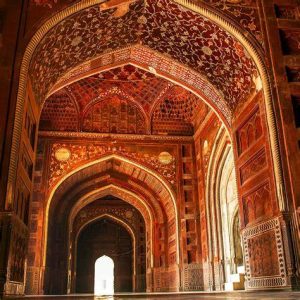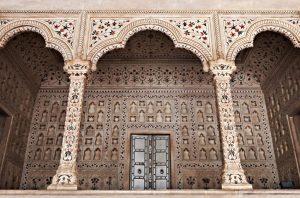

- The advent of the Mughals brought a new era in architecture.
- Indo-Islamic architecture reached its zenith during this period
- The first building of this rule was Humayun’s Tomb at Delhi. Red sandstone was used in this building. It has a main gateway and the tomb is placed in the midst of a garden. Many consider it a precursor of the Taj Mahal.
- Akbar built forts at Agra and Fatehpur Sikri. The Buland Darwaza reflects the grandeur of the mighty Mughal Empire. This building was made following Akbar’s victory over Gujarat
- The tomb of Salim Chishti, Palace of Jodha Bai, Ibadat Khana, Birbal’s Houseand other buildings at Fatehpur Sikri reflect a synthesis of Persian and Indian elements.
- During the reign of Jehangir, Akbar’s Mausoleum was constructed at Sikandra near Agra. He built the beautiful tomb of Itimad-ud-daulawhich was built entirely of marble.
- Shahjahan was the greatest builder amongst the Mughals. He used marble extensively. Decorative design in inlay work, (called pietra duro) beautiful arches and minarets were the features of his buildings
- The Red Fort and Jama Masjid of Delhi and above all the Taj Mahal are some of the buildings built by Shahjahan.





